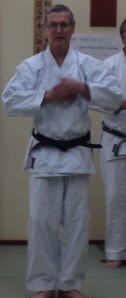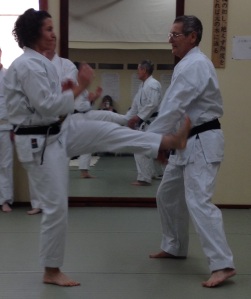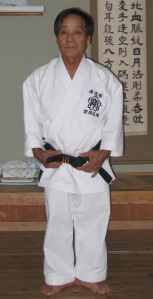A long-time student and friend is leaving the dojo this month. We’ve been training together for about 12 years and he and his wife are moving back to Sweden. He has been consistent, he trains hard, and he is one of the people I regularly see at the dojo working out before class. He has recently earned a well-deserved ni-dan, and continues to push himself and grow. I always look forward to his carefully thought out questions about training, and to the interesting conversations we have about history and politics. It has been a pleasure getting to know him, and he will be greatly missed.
I’ve been his teacher for a long time, and his leaving has me thinking about the role of a teacher, and who one’s teachers actually are. When I talk about my teachers I mention people like Kimo sensei, Sakai sensei, Gakiya sensei, and Liu sifu. But there is another group that often gets left out of lists like this. Most of my learning has been with the help of students who trained alongside me and, in more recent years, with the help of my own students. They are the people that I have worked out questions and problems with. The people I have done thousands of reps with, and whose questions have driven me to examine my practice, correct my mistakes, and keep learning. In a very real sense people like Corey, Mike, David, Shinji, Michael, Nagata, and of course Per have been the most important teachers I have had.
It is sometimes hard to quantify just what different people teach you. Per rarely misses training. When he does, it is usually because he has been doing a project at home and has either had a minor injury or is completely worn out. Both his stories and the matter-of-fact way he delivers them have become part of our dojo lore. Some of my favorites include: “I shoveled an entire truck load of gravel into my basement through a window yesterday and my back is a little sore;” “I was replacing a beam in my basement and a steel plate fell on my head. I think I need stitches.” and most recently “I had oral surgery this afternoon. I wasn’t going to tell you because I figured I would be able to come anyway, but the anesthetic has me feeling off.” I think it honestly does not occur to him that any of these are a reason to miss training until he gets up to go and realizes perhaps he needs to recover a bit more.
Training is holistic. It is partly about learning new material- mechanics, tactics, etc., but it is also about integrating what you bring to the table. One thing Per brings is that attitude. I remember looking down a line of people doing body conditioning, contorted faces flinching at the pain of impact. Per was down the other end, a rather serene look on his face as his partner’s shin met his right thigh. His left was off limits due to a knee injury so he had his partner double up on the right. When we finished that drill he said “Are we done? OK. What’s next?” It never occurred to him not to come to training due to the injury, he just worked around it.
That attitude is something that is hard to cultivate. While we try to inculcate it in the dojo, it is also something Per brought with him. When he used to travel for work he would bring a step in his luggage so he could work out in his hotel room. That is the same thing: circumstances do not dictate what you can and cannot do, you do. Aside from details of technique and application, and from questions that have made me re-think what I thought I knew, this attitude is something that I have hopefully learned from him. It shows me he understands one of the core attributes of our practice.
I really hope I have an opportunity to introduce him to some of my friends and teachers in Okinawa someday. I think they would recognize kindred spirits in each other. Gibo Seki, for example, is 76 this year and trains every day. One afternoon in his dojo he removed his gi and his back was covered with analgesic patches- he had been helping install a floor the day before and his back was really sore. No reason to miss training though. Per started training with us when he was 62 and just turned 75. In our culture it is somewhat unusual for a person in their 70s to regularly do vigorous and hard contact training with people 30 years (or more) younger. Not so in Okinawa- most dojo are intergenerational spaces, and for good reason: the older teachers and students have a lot to teach the juniors, both in the art itself and in a more experienced approach to the process of training.
For Per, his age is just a circumstance and he trains without worrying about it. For me, it has been a benefit because, much like my teachers in Okinawa in their 70s and 80s, he is an example of what dedication and perseverance can accomplish. His hard and consistent training is something to aspire to, regardless of age. The disciplined and can-do way he approaches training is something else to aspire to. He trains hard, no caveats involved, and has no problem out-conditioning people 30 years his junior. He has also carefully adjusted his training over the years, keeping up the hard work but making sure he stayed healthy doing it. The lesson is simple- if you let circumstances dictate when and how you train, eventually you won’t be able to train at all. If you don’t there is no reason you have to stop. I plan to be doing this for the rest of my life, and he is one of the people who is teaching me how to do just that.
So we will miss him. The stories of why he might miss training. The can do attitude. The constant presence in the dojo, and the hard work he is always willing to do. It has been great training with him, and an honor being his teacher. He is part of our community and it will change without him. I know we’ll see him when he is back in the area and he will always be a member of the dojo. But it would be nice if he could still be here every day.
As I get a little older, and my training partners and students age along with me, it is easy to fall into the trap of “well, I’m not in my 20s anymore”. Sure, I’m not, and I would be foolish to try to train the same way I did then if I want to be able to train in another 20 years. But the next time I’m looking down a line of people in their 30s and 40s (or a little older) and someone notes that x was easier when we were 22, I won’t have Per sensei looking back, without saying anything, wondering when we youngsters were going to stop whinging and just get on with it.




フレッドさん がんばってますね いろんな人がいて 指導者も勉強させられます まず 自分の修業 そして生徒さんの指導 がんばって 下さい 宮城 鹿児島より
LikeLike
宮城先生、ありがとうございます。まだまだがんべってみす!
LikeLike
Per in welcome to continue his training with us after to moving back in Sweden if he is staying close to our dojo in Åkersberga, north of Stockholm.
LikeLike
So many relevant Chuck Norris jokes come to mind, but you know Chuck Norris was a greater actor of toughness, Per, however, is tough!
LikeLike
Pingback: Who Are Your Teachers, Pt 2: Who They Are Not | Kodokan Boston
Admiring the time and energy you put into your website and detailed information you present.
It’s great to come across a blog every once in a while that
isn’t the same out of date rehashed information. Fantastic read!
I’ve bookmarked your site and I’m adding your RSS feeds to my Google account.
LikeLike